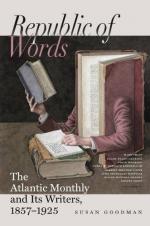After we had examined all that was to be seen here, our next point of interest was a graveyard, which, we had been informed by some of the household at Mrs. Carroll’s, had been preserved upon the estate from a very early period. Our old gossip professed to know all about this, from its very first establishment. It was in another direction from the mansion-house, about a mile distant, on the margin of an inlet from the Bay, called Harper’s Creek; and thither we accordingly went. Before we reached the spot, the old negro stopped at a cabin that lay in our route and provided himself with a hoe, which, borne upon his shoulder, gave a somewhat mysterious significance to the office he had assumed. He did not explain the purpose of this equipment to us, and we forbore to question him. After descending to the level of the tide and passing through some thickets of wild shrubbery, we arrived upon a grassy plain immediately upon the border of the creek; and there, in a quiet, sequestered nook of rural landscape, the smooth and sluggish little inlet begirt with waterlilies and reflecting wood and sky and the green hill-side upon its surface, was the chosen resting-place of the departed generations of the family. A few simple tombstones—some of them darkened by the touch of Time—lay clustered within an old inclosure. The brief memorials engraved upon them told us how inveterately Death had pursued his ancient vocation and gathered in his relentless tribute from young and old in times past as he does to-day.
Here was a theme for a sermon from the patriarch, who now leaned upon his hoe and shook his head with a slow ruminative motion, as if he hoped by this action to disengage from it some profound moral reflections, and then began to enumerate how many of these good people he had helped to bury; but before he had well begun this discourse we had turned away and were about leaving the place, when he recalled us by saying, “I have got one tombstone yet to show you, as soon as I can clear it off with the hoe: it belongs to old Master Rousby, who was stobbed aboard ship, and is, besides that, the grandest tombstone here.”
Here was another of those flashes of light by which my story seemed to be preordained to a prosperous end. We eagerly encouraged the old man to this task, and he went to work in removing the green sod from a large slab which had been entirely hidden under the soil, and in a brief space revealed to us a tombstone fully six feet long, upon which we were able to read, in plainly chiselled letters, an inscription surmounted by a carved heraldic shield with its proper quarterings and devices.
Our group at this moment would have made a fine artistic study. There was this quiet landscape around us garnished with the beauty of May; there were the rustic tombs,—the old negro, with a countenance surcharged with the expression of solemn satisfaction at his employment, bending his aged figure over the broad, carved stone, and scraping from it the grass which had not been disturbed perhaps for a quarter of a century; and there was our own party looking on with eager interest, as the inscription every moment became more legible. That interest may be imagined, on reading the inscription, which, when brought to the full light of day, revealed these words:—




